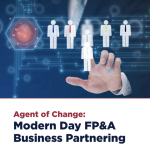In this article, the author explains how Artificial Intelligence (AI) can help FP&A professionals become invaluable...

Your upcoming fiscal year’s Strategic Planning and objectives are defined, aligned and signed. It’s now time for Budget Planning. Budget Planning – the annual time for the finance and FP&A team members to schedule meetings with the functional organisations’ budget leaders to discuss and review the priorities and what expenditures will be required. Whether using a 'Zero-Based' Budget process or starting with the prior year’s 'run-rate' expenses, the budget cycle has a kick-off point for the conversations and discussions of required operating expenses and capital expenditures.
Too often, budget meetings launch with the functional leaders asking, requesting, and sometimes even demanding expenditures that may be significantly beyond a feasible financial scope and, frequently, beyond the strategic plan’s scope. The financial partner is placed in the uncomfortable position and role of being the “no” person for what budget cannot be provided, and what's worse, considered to be just a "number cruncher". Tensions can arise from this point and can lead to inefficient use of time, with the budget cycles requiring many iterations and rework.
As finance professionals, we have used various planning tools, applications, and systems for budget creation, monitoring, and reporting. Soft skills are not commonly taught or practised. These include the core collaboration skills that help drive more effective budgeting cycles and focus on critical investments. Developing these soft skills results in authentic Business Partnering, opening up the opportunity to build and grow relationships where the FP&A team member is dynamically "pulled" into critical and strategic budget planning contrary to the requirement to "push" for involvement and inclusion. Strong skills in these collaborative tools will result in the FP&A team members truly having a seat at the table instead of waiting outside the proverbial board room.
If the above scenario and budgeting challenges resonate with you, let's explore a method that will offer a path to develop and experience Business Partnering for the finance function.
Our Aim: A Blueprint for Building True Business Partnering
I aim to provide a simple guide for finance professionals to help them develop and enhance true Business Partnering, support and drive to a critical spend-optimised budget within the schedule provided and retain minimal variances to forecast while meeting company goals, milestones, and deliverables. Most importantly, ensure the finance professionals leading the budget process demonstrate perceived value and transcend beyond being simple "number crunchers".
To achieve this, additional effort will be required from the finance professional to establish this foundation and framework, including reliance on these key tools and skills:
- Keeping an open and curious mind with an always-learning mindset
- A willingness to ask questions and truly actively listen to the answers
- Exercising patience and maintaining a collaborative perspective.
Let's get started on the creation of that foundation and framework.
To make the framework more memorable, we will use the acronym CLUE.
- C = CREATE the relationship
- L = LEARN the business/function
- U = UNDERSTAND the priorities
- E = ENGAGE with budgets/financials
CREATE the Relationship
Whether we work in an office, are remote, or are in a hybrid setting, we operate in a typical professional business environment. In addition, as in any social situation, the goal is to establish solid, foundational relationships. This means we will need to ask each one about themselves when initially engaging with budget leaders, management, or other workplace colleagues before diving right into any business topics or objectives. This can include their weekend activities, vacations planned and taken, hobbies and events, and more. It's all about asking them questions and frequently using phrases such as "Tell me". For example, "Tell me about your recent vacation..." Be sure to actively listen to the response and politely ask more genuine, layered and probing questions to learn more details. While this may seem obvious, in today’s work environment, this has become less frequently practised over time and has become a diminished skill set. Keep in mind that everyone has a story. Asking honest, earnest questions and exercising active listening will help you find and land on the desired "common ground" and provide you with more potential areas for enhancing your relationship and establishing a true “connection”.
LEARN the Business/Function
Many finance professionals only focus on the financial deliverables and do not try to learn or understand the technology, functional area, or business. To remedy this gap, schedule time with the budget function leaders during non-budget timeframes to be curious and learn more about the business and other functions (e.g., R&D/Engineering, Marketing, Sales, etc.). Sit down with each leader, starting with 30 minutes for each, and keep your open-minded perspective with a learning and growth mindset. As with building the relationship, use the words "tell me" to learn more about their role, their business and technical challenges, and inquire about any recurring frustrations or perceived barriers. Ask about technology and technical areas, industries and markets, growth and new customer opportunities, and their future vision.
UNDERSTAND the Priorities
Once you learn more about the business and their current challenges and obstacles, you can dive into understanding their priorities. This may include their 30, 60 and 90-day objectives, their projects’ milestones and goals, and critical deadlines and deliverables. You can then move to areas where the finance professionals add more value. Ask them questions such as “How can I help?”, “What are your most critical short-term and long-term objectives, and how can I help remove roadblocks?” This assistance step may also include the best ways to drive towards monetising the resources and investments that would best match and fit with their goals and objectives, even though you haven’t even started talking about budgets yet.
ENGAGE with Budgets/Financials
The last step is where we finally start talking dollars and sense. We engage with the budgets, the financial requirements and boundaries. We are most familiar with this step, but you can now proceed with more confidence built on a solid relationship foundation.
Conclusions
By now, you have the CLUE needed and are well-connected with your budget leaders. You have that "seat at the table", and the budget leaders are more willing to engage with you in true Business Partnerships. You understand their priorities and are now a trusted advisor, so the creation of the budgets can still be standardised per company requirements yet "flexed" to accommodate and best align with their unique and desired functional needs. Additional benefits will include reduced budget iterations and minimal variances to forecast while meeting company goals and deliverables.
Get your CLUE going today and enjoy the rewards of Business Partnering.
Subscribe to
FP&A Trends Digest

We will regularly update you on the latest trends and developments in FP&A. Take the opportunity to have articles written by finance thought leaders delivered directly to your inbox; watch compelling webinars; connect with like-minded professionals; and become a part of our global community.






